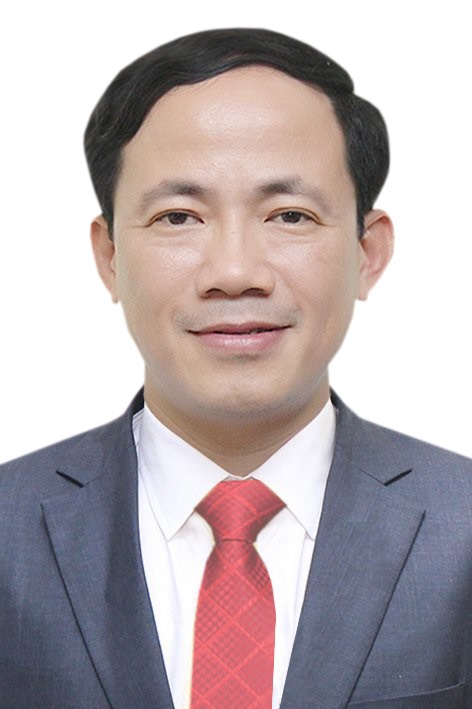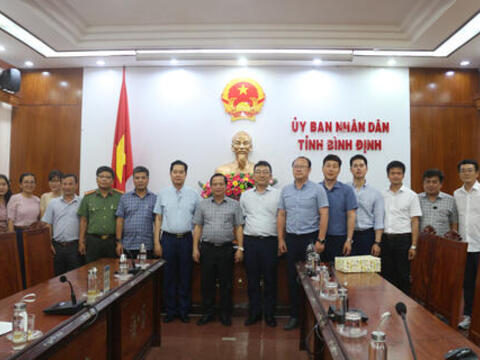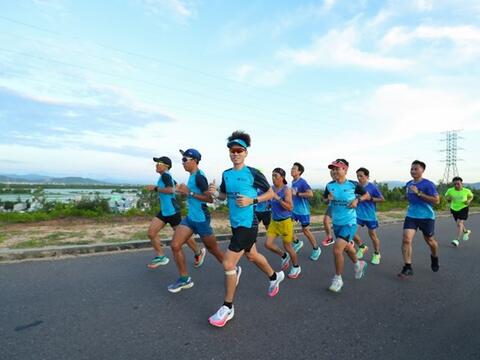Binh Dinh has a very ancient cultural source, if the North has the Dong Son culture, the South has the Oc Eo culture, then Binh Dinh, the midpoint of the Central region has the Sa Huynh culture and famous Champa culture. Inheriting a cultural source that must be said to be very ancient and massive, after thousands of years of building and maintaining the country, Binh Dinh culture has both spread and absorbed the values of other cultures to foster , enrich yourself.
Binh Dinh people are very proud and always conscious of preserving, preserving and promoting the traditional cultural capital left by their ancestors, enriching today's life. Anyone who has been to Binh Dinh once will never forget the ancient Champa towers, built hundreds of years ago but still arrogant, brave and old, ecstatically beautiful by the sophisticated and contained architecture. many mysteries. And in the background of that ancient culture - civilization, the land of Binh Dinh has always been the place where unique cultural lines and trends have been discovered. There are many opinions that the art of tuong has reached the classical level, a precious capital of the nation that has flourished in the land of Binh Dinh associated with the name of the excellent dramatist Dao Tan.
During the Tay Son peasant uprising, three Nguyen cousins, Nguyen Nhac, Nguyen Hue, and Nguyen Lu, after wiping out internal and external enemies, built Tay Son culture as a cultural revolution. culture, in which the Nom script is emphasized, paving the way for the national culture to develop in association with national sovereignty and independence. In the early twentieth century, in the line of pre-war poetry from 1930 to 1945 with the new poetry movement, Binh Dinh was also considered as the birthplace of a composing movement along with outstanding poets such as Xuan Dieu, Che Lan Vien, Han Mac Tu, Cu Huy Can... Experiencing two holy wars of the nation, Binh Dinh culture also contributed a significant part to the cause of national liberation. Remember, those heroic years, along with the movement of Singing over the bombs, the sound of loudspeakers mixing with the gunfire of the whole country, Bai Choi opera and Binh Dinh tuong once resounded throughout the resistance base area and even in the war. enemy regions through radio waves of Liberation Radio and Voice of Vietnam, cheering and nurturing the souls of the resistance, fighting for the independence and freedom of the nation, etc.
The breaking points of Binh Dinh culture have passed like that, but what is Binh Dinh culture for today and tomorrow is very important, it is necessary to set a direction for the culture in accordance with the law of social development, in accordance with the characteristics of the country's economy in the period of industrialization - modernization. Because when it comes to culture, although it is the driving force of socio-economic development, culture depends on economic conditions, so when it comes to Binh Dinh culture with a future view, Binh Dinh culture also suffers the influence of the province's economy; Therefore, determining where Binh Dinh's culture will go and how it will look in the future is very necessary. In fact, the cultural issues of Binh Dinh are of the most general nature and have been oriented in the Resolutions on culture and arts of the Communist Party of Vietnam, and the most recent and most specific is the Resolution of the Conference on Culture and Arts. The 5th session of the Central Committee of the Communist Party (Term VIII) on building and developing an advanced Vietnamese culture imbued with national identity. To concretize this Resolution, Binh Dinh Provincial People's Committee has issued a strategic plan on the development of culture and information until 2010 and a series of other projects to promote and untie the development of culture and art. It can be said that a series of new policies and projects on culture - art have been promulgated, which has greatly encouraged the development of Binh Dinh culture; Those are the sticks for culture makers to set out for themselves a specific and practical direction in the direction of ensuring that culture is both a goal and a driving force for socio-economic development.
In general, Binh Dinh culture is not outside the general orientation of Vietnamese culture operating in the market mechanism, with the State's management according to the socialist orientation. When asking the specific question of which direction for Binh Dinh culture to go to the future, it must definitely be based on the characteristics of the region and the strengths Binh Dinh has. Binh Dinh culture wants to have a spectacular breakthrough, it must stick to the roots of traditional culture which is very rich and diverse, because this is the most solid foundation. Cultural development in Binh Dinh, perhaps first of all, must go from the system of historical and cultural relics. That is, it is necessary to know how to promote the strengths of these monuments to exploit and introduce their values to the outside. According to incomplete statistics, Binh Dinh currently has 260 relics and scenic spots under planning. Of these, up to now, over 30 relics have been ranked by the Ministry of Culture, Sports and Tourism, about over 50 are recognized by the Provincial People's Committee, and the rest are being surveyed and built to determine the identity of the people. level of value of each relic, which level is recognized by that level. The historical and cultural relics in Binh Dinh province contain the patriotic and revolutionary spirit of the people of Binh Dinh, the most popular are the following groups: relics of ancient Champa culture, relics of Tay Son - Nguyen Hue, relics of the French resistance and the Revolution, relics of the anti-American resistance war and monuments - scenic spots.
Intangible cultural lines in Binh Dinh are extremely rich such as: Festival activities, Boi singing (Tuong), Tay Son martial music, Bai Choi singing, dancing and singing of coastal residents... are unique spiritual dishes not only for the people of Binh Dinh but also a specialty to introduce to other provinces and international guests. Festivals with traditional and folk characteristics, if maintained and promoted, will also be the future cultural face of Binh Dinh such as: Dong Da Victory Festival (Tay Son), Fishing Festival (Tay Son) coastal communes), Go Market Festival (Tuy Phuoc), Mountain Culture and Sports Festival, Coastal Sports and Culture Festival... and countless festivals of religious and human nature The literature of three ethnic minorities in mountainous areas: Bana, Cham, and H're living in Binh Dinh is the source of a culture imbued with national identity. And of course, the above cultural types must be enhanced and modified to suit the new aesthetic needs.
Folklore and scholarly literature in Binh Dinh is also a strength in the period of integration and development. It is proved that the current composing team in Binh Dinh is increasing day by day, all ages have; Over the years, many of their works have won high prizes in many fields from: art, painting, poetry, music to traditional theatrical performance. Folklore is still here, the artisans, the next generations follow in the footsteps of their forefathers, preserving the dialogues, good performances, folk songs and old hut singing, along with folk games during festivals, the good customs and habits of Binh Dinh people forever adorn the face of Binh Dinh culture.
Future Binh Dinh culture also knows how to absorb the cultural quintessence of regions in the country and humanity; The reason why it is important to appreciate the absorption of the beauty and beauty of the cultures of other regions is also an indispensable requirement in any culture when it wants to exist and develop. Whether Binh Dinh culture integrates with the outside world or not, the factors of absorbing, accreting and accumulating for themselves are very important. In the world of the great industrial era, Binh Dinh culture not only kept its own characteristics such as Hue has royal singing and dancing, the Northern Delta has cheo, the South has cai luong, and the Central Highlands has T'rung music. etc but also to ensure harmony in the multicolored but unified culture of Vietnam.
However, in order to have a developed cultural area, Binh Dinh is also facing many difficulties and challenges. Those are the downsides of the market mechanism, once it is necessary to limit the ideas that promote money and fame or commercialize culture. These difficulties and challenges, in fact, in recent years, Binh Dinh has also encountered and is trying to limit them not to hinder them in the general development of Binh Dinh culture.
Today, with the policies of the Provincial People's Committee, the intelligentsia, the cultural and artistic staff in Binh Dinh are growing up day by day. This is a very important resource to create the shape of Binh Dinh culture in the future. That will be the driving force to directly promote the whole country towards building an advanced Vietnamese culture imbued with national identity, preparing oneself with the best luggage to go to the twenty-first century.
Ethnic compositions
Bana people (Bahnar – Bahnar)
The Bana people belong to the Mon-Khmer language group. In addition to the name Bana, the Bana people in each region and each locality also have different names such as Golar, Tolo, Gielong (Ylang), Ro Ngao, K'rim, Roh, Conkdeh, Ala kong, K. 'Pong kong, Bo Nam...
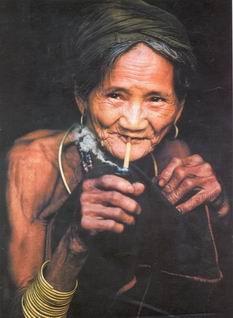
Bana people (Bahnar - Bahnar)
The Bana ethnic group is a long-standing indigenous population in the Truong Son - Central Highlands region, with an attractive and interesting ancient culture, which is ranked 12th among 53 ethnic minorities in Vietnam.
In Binh Dinh, the Bana reside in the districts of Van Canh, Vinh Thanh, An Lao, and 3 communes in Hoai An district, 1 commune and 3 villages in Tay Son district.
The Bana people in Hoai An recently moved from Vinh Thanh. The Bana people in Van Canh, in the process of existence and development, have had a very strong cultural exchange with the Kinh people, especially the Cham people who live nearby. The phenomenon of exchange, exchange and cultural influence between the Cham and the Bana people in Van Canh has formed a very special cultural interlacing state here. Therefore, the Bana people in Vinh Thanh still retain many of the most ethnic-specific cultural features among the Bana people in Binh Dinh.
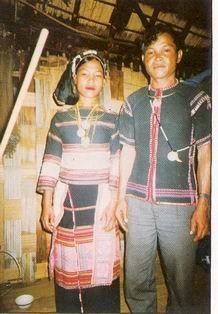
The Bana people in Vinh Thanh are called Bana K'riem by the Bana community in the area. The semantics of the Bana K'riem people today have many different interpretations. Most of the opinions of the Bana people in Vinh Thanh admit: The noun K'riem means the Bana people in the lowlands, living around Dak K'riem. The Bana people in Vinh Thanh say that: In terms of origin, they have the same origin as the Bana people in Gia Lai.
Meanwhile, the Bana people in Van Canh are called Bohna - Chamroi, or Bana Bang Huong. Regarding the ancient origin of the Bana division in Van Canh today, there are many different opinions. There are suggestions that: maybe in the past, the Bana here were the Ma da people that the Cham inscription mentioned. Through a process of struggle for survival and subject to historical upheavals, the Bana people in the coastal area have gradually moved to higher areas to live. But some other opinions put the Bana people in Van Canh into a separate division called Bana - Cham.
Thus, although there are many different opinions about the Bana people in Vinh Thanh and Van Canh, we can confirm that the Bana people in Binh Dinh are an inseparable parts of the Bana community. The Bana people in Binh Dinh today still retain many cultural features of the Bana community in general. However, in the process of migration, disturbance, intermingled living, settled near, the Bana people in Binh Dinh (especially the Bana people in Van Canh) have come into contact with and interwoven with many cultural elements of the Cham and Kinh people (Viet) live besides.
H're ethnic group
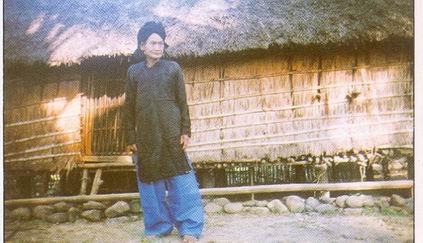
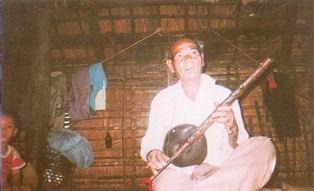
H're ethnic group
During their survival and development, the H're have many different names. The H're people attach their own names to the names of rivers and streams where they reside. For example, in Minh Long (Quang Ngai province) there is a river of Rvá, called "Rvá people", in Ba To there is a Lien river called "people of Lien country" ... H're is the name of a section upstream of Tra Khuc river, flows through the area where the people live and has become the official name of this ethnic group.
In the mountainous region of Binh Dinh, the H're live mainly in An Lao district. That's why when talking about the H're people in Binh Dinh, we pay special attention to the H're people in An Lao district.
The H're live very concentrated in the communes of An Lao district. The H're people, whether living in Binh Dinh (An Lao, Vinh Thanh), Gia Lai or in Quang Ngai (Nghia Hanh, Mo Duc) belong to the Mon - Khmer language group in the mountains. Regarding the origin of the H're people, there are still many different opinions. However, the H're themselves consider the western region of Binh Dinh (An Lao), Quang Ngai (Son Ha, Ba To, Minh Long, Tra Bong, and Tu Nghia) to be the land that their ancestors explored in the past. . In the legends about the origin of the nation, the H're people often mention the names of the Mun and Rin mountains, and consider them as the origin of the nation. The H're people in Binh Dinh, Quang Ngai in their economic activities have a rather peculiar feature that besides shifting cultivation, this ethnic group has known from a very early age to cultivate wet rice by the method of "irrigating the fields".
Cham people
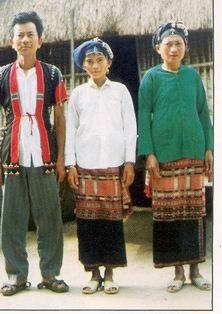
Cham people
The Cham (Cham Hroi) in Binh Dinh, Phu Yen have a close relationship with each other and have a development process that is both common and unique, which is worthy of attention in the Cham (Cham) community across the country.
In Binh Dinh, the Cham people reside concentrated in Van Canh district. In Van Canh district, the Cham live interspersed with the Bana and Kinh people. Cham people in Van Canh district, Binh Dinh province have many different names and self-names: Cham Hroi, Hroi, A roi, Cham DacRay, Cham Hodang, Cham Deo ... According to the Cham people in Van Canh, Cham Hroi (or Hroi, A roi) are only Cham people in the highlands, Cham people in the mountains. Cham Dac Ray or Cham Ho is the Cham side of the rising sun. The Cham people explained: In the past, the Cham lived in the lowlands, in the sunrise region, then they moved to the highlands (the area is called Hroi). Currently, the Cham people in Van Canh are very proud to associate the meaning of Cham with the meaning of "Cham the rising sun". As for the Cham Deo (doesn't mean only the Cham on the other side of the pass) is the name of the Cham people in Phu Yen who call the Cham people in Van Canh ... Currently in the scientific world there is no definite conclusion about the origin of the Cham people in Binh Dinh and in Phu Yen. Scientists confirm that the Cham (Cham Hroi) in Binh Dinh, Phu Yen are part of the Cham (Cham) community in Vietnam.
It is possible that the origin of the Cham people in Binh Dinh and Phu Yen is the ancient Cham people. These ancient Chams, after the defeat of King Champa in Do Ban citadel, fled to the mountains and settled there. In the process of living in the mountains, due to separation from the original community, due to the exchange and influence of the Bana people who lived before so in the culture of this part of "Cham mountainous area", elements gradually appeared new cultural element. Those newly formed cultural elements were further consolidated and promoted when the process of interspersed and near-migration was accelerated at a great speed in Van Canh land in later times.
It is also possible that they are local groups of the ancient Cham people, who were present in the land of Binh Dinh and Phu Yen before. These ethnic groups in the process of their existence and development have both brought elements of their original culture (Cham culture) and other cultural factors from changes in the environment life created.
KEEP AND PROMOTE THE CULTURAL IDENTITY OF THE ETHNIC MINORITY OF BINH DINH
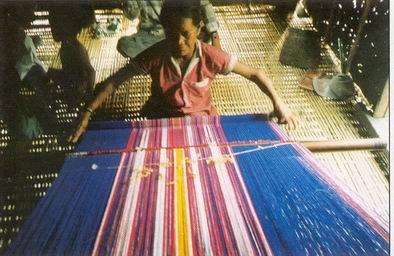
The Cham people weave cloth
Life assurance culture is one of the cultural fields that are very agile, in terms of absorbing, borrowing or innovating, reforming. Therefore, in order to preserve, preserve and promote the national cultural identity in this field, we need a dialectical, scientific and dynamic view. Thus, according to us, in the construction of settlement villages in the mountainous Binh Dinh, now we must pay attention to the village size, to the origin, to the production conditions and to pay attention to the featured of a Cham village, Bana and H're before (the traditional structure of a Cham village is usually tight, balanced, and harmonious, while that of the Bana and H're are concentrated, gather, and encapsulated). We need to pay attention to the sustainable and solid element in the structure of the stilt house of the Bana, H';re, or the symmetrical and airy element of the Cham's stilt house. With the increasing trend of changing from living in stilt houses to living in houses among the Cham, Bana, and H're people today, we see that all levels of the Party committee and local authorities need attention and thoughtful explanations, and should not be left to the situation. We think that in mountainous areas, if the loss of stilt houses, or communal houses, means that the traditional cultural values have been lost or lost. Thus, keeping the small, pretty houses (in all three ethnic groups Cham, bana, H're), the big beautiful Rong houses (in the Bana people), keeping the skirts, dresses, headscarves, clothes jewelry, keeping the rice lam, sour porridge, the custom of drinking wine ... is to retain invaluable assets for generations to come. Of course, besides the wasteful eating and drinking characteristics (especially during festivals, weddings, funerals), unhygienic eating, raising livestock and poultry under the floor ... we need to overcome , remove.
It is necessary to educate, encourage and encourage the Cham, Bana, and H're people to use and wear more national costumes, headscarves, jewelry, etc. At least in the holidays, festivals, New Year's Day, happy days of the people, encouraging people to wear and jewelry in the ethnic style. Particularly for well-off families, it is necessary to encourage them to shop and use high-class material facilities such as beds, cabinets, tables, chairs, electrical appliances, etc. That is also the way to combine tradition and modernity in the current reform and innovation process.
For culture and social norms
The beauties in the culture and social standards of the Cham, Bana, and H're ethnic groups in Binh Dinh province are reflected in the behavior of village communities and clans (for the Cham, the H're, and the bloodline for the Bana), through the family, or specifically and inclusively through human-to-human relationships. That is the love of the homeland, the love of labor, the attachment to the mountains and the forest, to the nation. It is hospitality, sincere affection, rustic, is the tradition of respecting the elderly (the old age tradition). That is equality, democracy, community in the treatment of people, sustainability in marriage and family life ... Before the changes of living conditions and current society, the requirements are: must respect, preserve and promote those fine cultural traditions. It also means that with characteristics such as inferiority, inferiority, locality, locality, ethnicity or averageness ... we need to eliminate. We believe that egalitarianism among ethnic minorities in Binh Dinh has the advantage of creating a averageness or balance in society, but its disadvantage is holding back, restraining and especially failing to create rivalry, the "big shocks" in development.
For intangible culture
The intangible cultural value of the Cham, Bana, and H're ethnic groups in Binh Dinh province is expressed through the diversity of beliefs and traditions, through the festival system, and especially through the richness of various forms of art. We believe that the special festivals of the Cham, Bana, and H're ethnic groups in Binh Dinh such as the buffalo stabbing festival, the early spring festival, the worshiping ceremony related to the crop production cycle, the water trough offering ceremony or rituals related to a person's life..., are cultural and spiritual activities that not only meet the spiritual needs of the people but also have the effect of strengthening the sense of community, educating and transmitting experiences related to production. Especially today, in the spiritual and cultural life of the Cham, Bana, and H're ethnic groups in Binh Dinh province, they still retain many precious folk art capital. These are stories, khans, H'amon, folk poetry, dance forms and genres, and sculptures. It is also the richness of musical instruments, of gong orchestras... The above cultural and spiritual values have become pride and need to be preserved not only for the descendants of the Cham people, Bana, H're in Binh Dinh but also for the Vietnamese ethnic community.
In short, preserving and promoting the traditional cultural identity of ethnic minorities in Binh Dinh is preserving and promoting strengths in the economy, in dealing with the natural and social environment. That is the strength of the values of material culture, social culture, and spiritual culture that the Cham, Bana, and H're have created and live long with the nations. However, in today's life of building a new society, besides preserving and promoting the cultural values that have been filtered through time, we also have to know how to absorb the quintessence of the culture of the times, of scientific and technical advances. Only then can we successfully build "an advanced, modern Vietnamese culture imbued with national identity" as the spirit of the 5th Resolution (Term 8) proposed by our Party.
TRADITIONAL HISTORY
Ethnic minorities in Binh Dinh, though only 2% of the province's population, live in a large mountainous area. It was a place where the strategic importance of the South Central Revolution in general and Binh Dinh Provincial Party Committee in particular, was the base of the army and people of the province in the resistance wars against foreign invaders. There, throughout the nation's heroic history of fighting against the enemy to save the country, ethnic minorities in Binh Dinh have upheld their role of indomitable struggle, loyalty and profound loyalty. Under the feudal regime, from this land, many struggles of the ethnic minorities broke out consecutively, typically the people's struggle movement under the leadership of the leader Vo Lia (Vo Van Don) against the harsh regime of Lord Nguyen in Dang Trong (1769). At the end of the 18th century, during the Tay Son uprising, the Binh Dinh ethnic minorities in the Tay Son Thuong Dao area made great contributions. They not only participated actively in the uprising, together with the insurgents built the movement's first base, but also sheltered and protected a number of generals and insurgents from cruel and cowardly revenge of the kings and mandarins of the Nguyen Dynasty. The policy history of the Nguyen Dynasty also acknowledged that.
In 1739, from the Tay Son Thuong Dao base, the Tay Son insurgents swept down to capture Quy Nhon government, opening a nearly 20-year war under the leadership of Nguyen Hue - Quang Trung, overturning the yoke of rotten feudal rule of Nguyen - Trinh - Le Dynasty, defeated the invaders of Siam (1774 - 1775), Man Thanh (1788 - 1789), re-unified the country, firmly defended national independence. In the glorious victories of the red-shirted barefoot army, emerged the courageous and loyal role of the army of elephants and skilled crossbows of the ethnic minorities in Binh Dinh.
Until now, the people of An Khe - Vinh Thanh area still handed down and preserved legends and relics about the glorious Tay Son period. It is the story of "Lord Xa Dang and the wild horses" reflecting Nguyen Hue's talent for conquering village elders. The legends about the Lantern valley in Con Roi (Vinh Hoa), Nguyen Hue field and Ka Ton rock wall (Vinh Son). Especially the Bana people in Vinh Son region have kept the cannon of the Tay Son dynasty and taken care of Nguyen Hue's orange garden. That cannon is currently on display at the Quang Trung museum in Phu Phong - Tay Son, and the orange garden is in Kon Truch village, Vinh Son commune. In the areas of Van Canh, An Lao, according to legend, Tay Son insurgent army led by Quang Trung intercepted Nguyen Anh's army at Thi Nai gate, Nguyen Anh and the remnants fled into Deo village (now part of Canh Giao village, Canh Hiep commune), from there cross the forest to Da Loc (Dong Xuan district, Phu Yen). Currently, in Van Canh area, there are traces of the "Trai Temple" base (now in Canh Giao village, Canh Hiep commune) a weapons factory in the Tay Son period.
During the Can Vuong movement against the French (1885 - 1887) of the people of Binh Dinh, under the flag of "Binh Tay Dai Dai Marshal" of Mai Xuan Thuong (1860 - 1887), of Dao Doan Lich, Tang Bat Ho, people of all ethnic groups Ethnic minorities in Binh Dinh rebelled strongly, joining together eagerly to join the insurgent army to kill the enemy to save the country. In Vinh Thanh, there are still preserved legends and vestiges of the meeting between the Bana insurgents and the Vietnamese insurgents of Deputy General Tieu. Many mountainous areas in Binh Dinh used to be a food production camp, forging rudimentary weapons, as well as a place to train soldiers and hold prisoners of the insurgents. Ethnic minorities not only enthusiastically participated in the insurgency, enthusiastically transported food and weapons, but also contributed to the Can Vuong movement heroic and talented insurgent commanders like De Binh Nguyen Trung Thuan, Soldier Do Nguyen, Quan Tran, Quan Bo, Quan Nguyen ... Especially the movement to take care of local logistics for ethnic minorities. At present, the people still circulate the examples of rice donation to the insurgents such as Nam Da's mother, Do Thi Lai from Bana in Vinh Thanh.
That revolutionary spirit of the ethnic minorities in Binh Dinh was multiplied by the people when the French colonialists attacked Binh Dinh. The newspaper reported that the ethnic groups had protested fiercely against oppression and harsh exploitation, especially against the French, who stole land to set up plantations.
Since the beginning of the twentieth century, the movement against tax collection, oppression, exploitation, and control of the mountains and forests of the Cham, Bana, and H're ethnic groups has continuously broken out in many forms and different sizes…
In 1898, in Van Canh, ethnic minorities under the leadership of Vo Tru armed with knives, machetes, spears and marks gathered to the Cau River province to protest to demand "tax begging" and to demand punishment "water worms"
During the period from 1902 to 1906, in collaboration with the people in Vinh Thanh, the Cham, Bana, and H're in the area continuously rebelled against the French colonialists to occupy the mountains and forests to explore for gold, vultures, etc. Especially from April 16, 1908 to May 19, 1908, the ethnic minorities in Binh Dinh rebelled to confiscate the tax books of the generals, and together they moved to the provincial capital (now the township An Nhon) demanded punishment for the wicked, against high taxes and heavy taxes. Mr. Truong Cac, Nguyen Thien, Ung Van Le, Ung Van Dien, and Truong Di were both pioneers of the local anti-tax movement, as well as soldiers who "kidnapped" with the beggar army tax collection in Binh Dinh citadel.
Especially since 1937, ethnic minorities in the West of Binh Dinh have actively participated in the "Nuoc xu do" movement of ethnic minorities in the North Central Highlands. The main content of the movement was anti-collection, anti-tax, anti-oppression of the French colonialists, gaining the right to master the mountains and forests. The movement "Nuoc xu do" first emerged strongly in Dak To and Dak Sut areas, Mang Pen ... then spread to the west of Quang Ngai and Binh Dinh. The movement "Nuoc xu do" in the mountainous Binh Dinh started from 1937, in the summer of 1938 broke out with a large scale and fierce fighting form.
After receiving the "Divine Water" (1938-1941), a very strong anti-French movement attracted many ethnic groups in Binh Dinh to participate. Ethnic minorities in the mountainous areas of Binh Dinh province raised up the movement against tax collection, against conscription and especially the movement of non-cooperation with France. In many regions, the people have carried out "village runs" into the high mountain forests, cutting off the connection and control of the French garrison.
It can be said that since the French arrived in our country, during their 80 years of domination, they have never "pacified" the mountainous Binh Dinh. Their siege and sweep campaigns took place consecutively but all failed, the people in the forests and mountains of Binh Dinh remained indomitable, resolutely resisting the enemy in many forms, refused to cooperate, refused to be slaves for the enemy.
On March 11, 1945, Japan coup d'etat France, while France was confused and fluctuating, ethnic people under the leadership of the Party rose up to fight fiercely. Typically, the movement of youth students to fight against the French invaders of Mr. Mang Thoong (Bana people), Mr. Mang Tan (Cham people) in Tuy Phuoc district (now Van Canh district, Vinh Thanh ...) Young people participating in the movement seriously wounded the French general at Van Canh fort.
In early May 1945, with the help of the Viet Minh Provincial Front, self-defense teams for national salvation in Van Canh, Vinh Thanh, An Lao and many other places were born. Among the elite children of the national salvation teams, there is the active participation of young people from ethnic minorities, typically comrades Mang Thoong (Bana people), Mang Tan (Cham people of Van Canh district), Binh Oying, Dinh Ton (Bana people - Vinh Thanh district).
In the last days of August, 1945, the revolutionary atmosphere boiled over the whole province. On August 23, the Viet Minh Front won the government. Immediately after that, a mass rally movement throughout the mountainous districts of Binh Dinh to celebrate the victory and declare the independence of the Provisional Revolutionary Government. Before that Revolutionary movement, the enemy government in the villages and communes disintegrated, the chiefs and chiefs had to submit documents to the Revolutionary government.
During the 9 years of resistance war against the French colonialists, the people of Binh Dinh ethnic minorities enthusiastically participated in the resistance movement, turning the mountains and forests into the base of the Revolution. That is the movement of "resistance vegetable beds", "resistance chicken flocks", "establishment of funds to raise troops", "gifts for soldiers on the battlefield"; that is the movement "adopting mother", "adoptive sister" directly nurtures and takes care of wounded and sick soldiers, the movement to form a guerrilla force to protect the homeland, to encourage their children to join the army, has grown strongly, spread to every village. After the August Revolution, the guerrilla team of Van Canh, Vinh Thanh, and An Lao districts became the core armed forces of the district administrative committees of resistance.
After 1954, the US imperialists and their minions carried out many malicious schemes, divided the national unity bloc, widely encouraged superstitions, divination, funerals, and at the same time seduced and bought ransom, force young people of all ethnic groups to serve as cannon fodder for them. They also surrounded and destroyed the economy, arrested and imprisoned, and terrorized people of all ethnic groups in order to extinguish the patriotism and fighting spirit of the compatriots. But right from the early days of the resistance war against the US, when comparing us and the enemy, especially the armed forces, there was still a huge gap, people of all ethnic groups still followed the Party with one heart and stood up with the Vietnamese against the enemy's grip. While the US - puppetry tried every way to establish a henchman government in the mountainous areas of Binh Dinh, in Vinh Thanh and many highland communes An Lao, Van Canh, organized a base of secret operations with a single line from 3 to 5 people have been set up to lead the people's struggle. At the beginning of 1960, in Vinh Thanh, a congress of people's deputies was held for self-governing of the district, and in 1964, two more districts of An Lao and Van Canh established the People's Committees of self-governing districts - communes - villages in the region ethnic people.
At the end of 1956 - 1957, the movement of 'extermination of qi and eradication' developed in the mountainous districts of Binh Dinh province. In An Lao, in June 1957, ethnic people secretly destroyed the name The - an evil secret agent in An Tuong commune and Nhieu commune An Toan, making the puppet authorities here very afraid. In June 1957, the Americans - puppets carried out a series of campaigns against the communists but failed. In November 1957, the enemy made a plan to gather people in highland communes and bordering areas between us and the enemy into branches to implement the strategy of "Slapping water to catch fish". In Vinh Thanh, they chose the villages of Ha Ri, De Tolok, and Konklot as a pilot. The compatriots, under the leadership of the Party, relied on customs and practices, refused to go, and fought fiercely with the enemy. Until the end of 1958, they still could not carry out the plan to herd the people.
Since the issuance of Resolution 15 of the Central Committee of the Party illuminating cadres and people of ethnic groups in the mountainous Binh Dinh, they have combined political struggle with armed struggle, between eradicating evil and anti-Te, Nguy military, puppetry, between fighting the enemy's army and building forces... On that basis, the armed forces creatively applied methods and forms of combat, fighting the enemy with all weapons from rudimentary to modernity, on all terrains, in all weathers and especially promote the power of people's war with the advantage of mountains and forests. History will forever record the heroic feats of the people of ethnic minorities in Binh Dinh such as the uprising in Vinh Thanh district on February 2, 1959, or the victory in the An Lao campaign in 1964...
A great contribution of ethnic minorities in western Binh Dinh is to build bases and nurture resistance forces. The Truong Son mountainous region in Binh Dinh, during the two resistance wars against the French colonialists and the American imperialists, was the base of the plain districts of Binh Dinh province and of the Central Central provinces. Ethnic people provided food and food, and protected the safety of the base area. The compatriots also contributed human and material resources to the nurturing and development of the armed forces for liberation. In many places, the hungry people only ate cassava, vegetables, about rice go all for the sake of the resistance.
Experiencing the resistance wars against the French and American, ethnic minorities in the mountainous Binh Dinh have made worthy contributions to the cause of national liberation and national liberation, and many heroic units and individuals have appeared. Representing the Cham, Bana, and H're ethnic groups in Binh Dinh, together with the people of the country, they created a great miracle - completely liberated the South and reunified the country in 1975.

 Tiếng Việt
Tiếng Việt  Print the article
Print the article